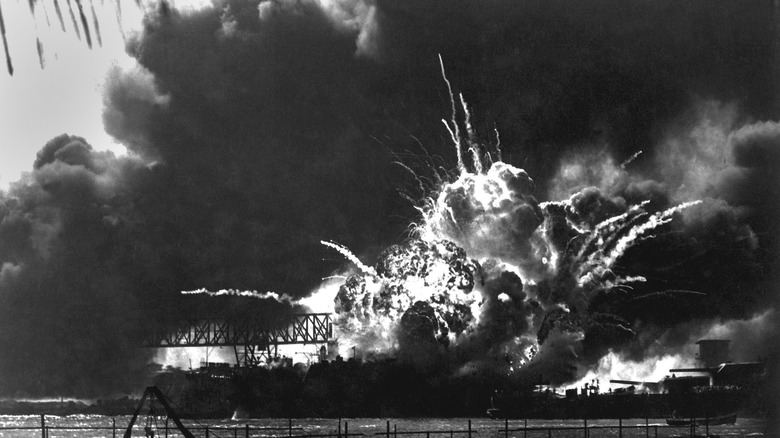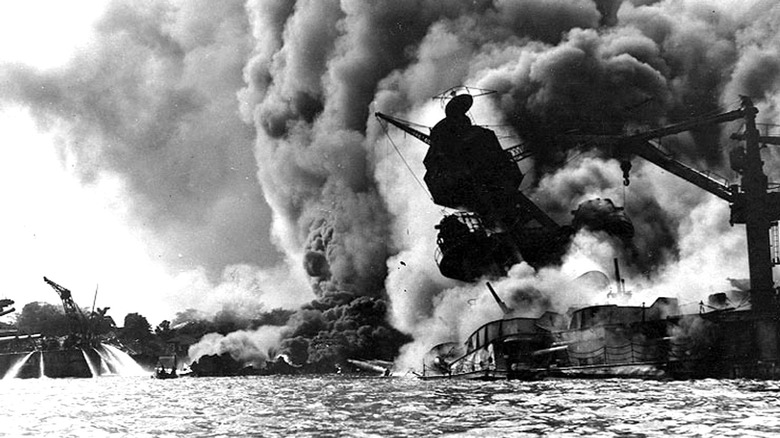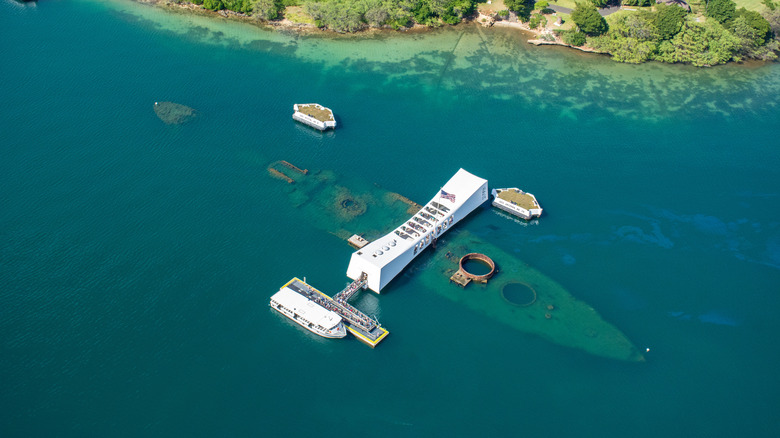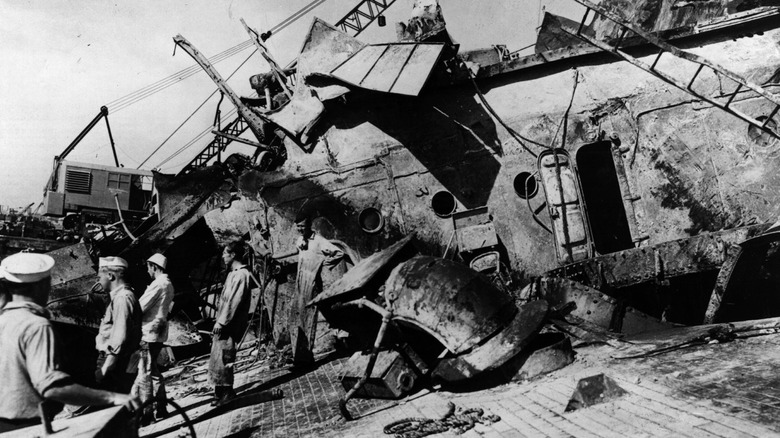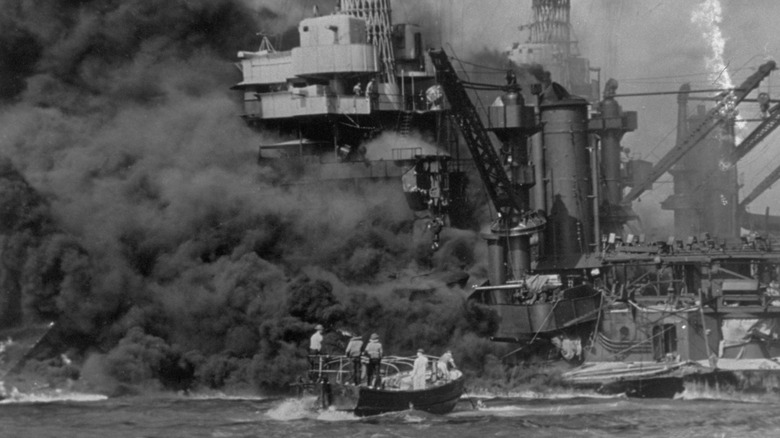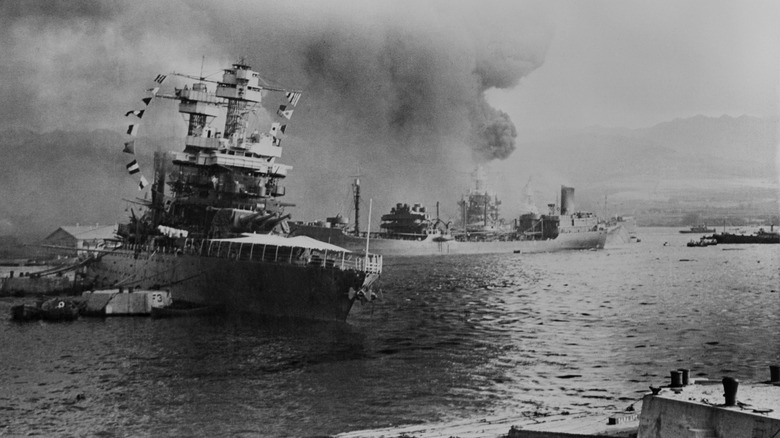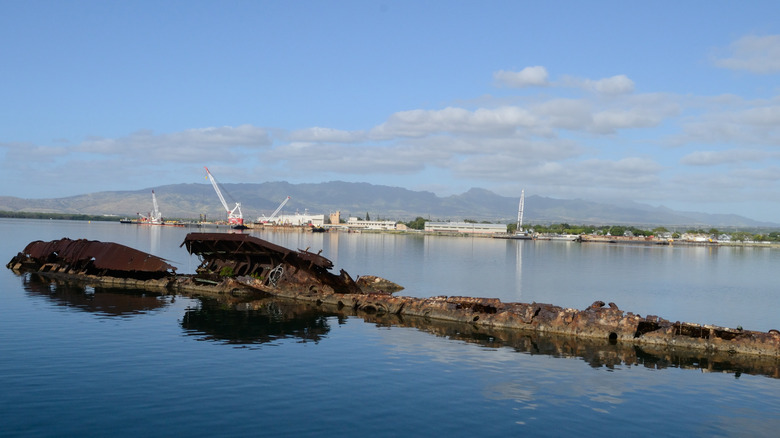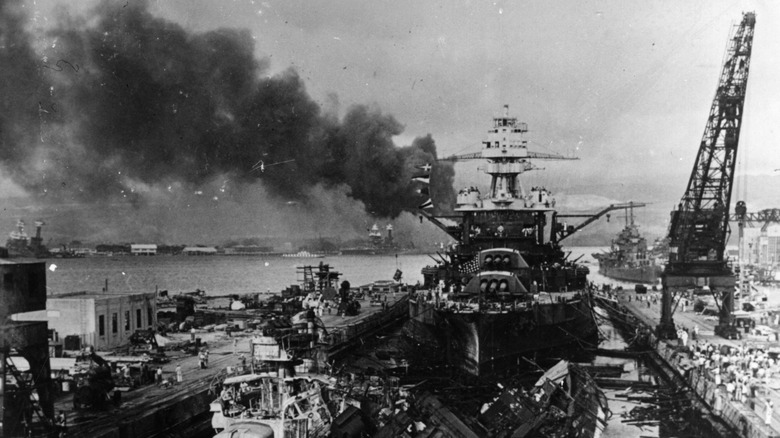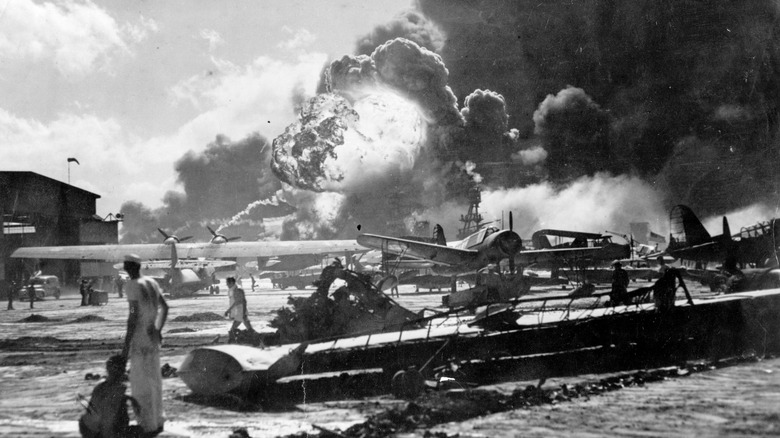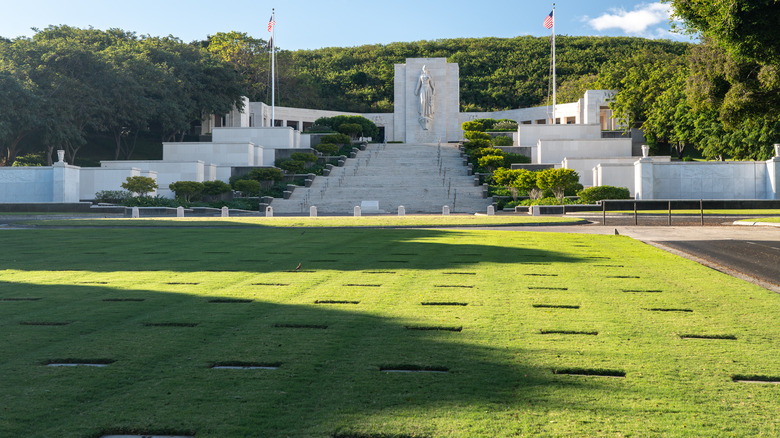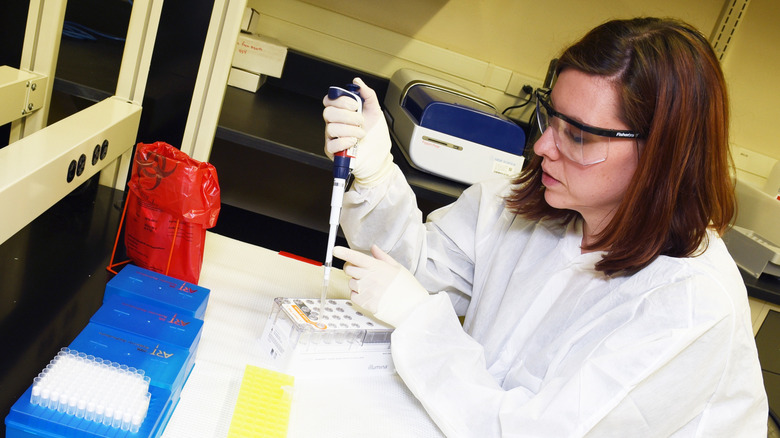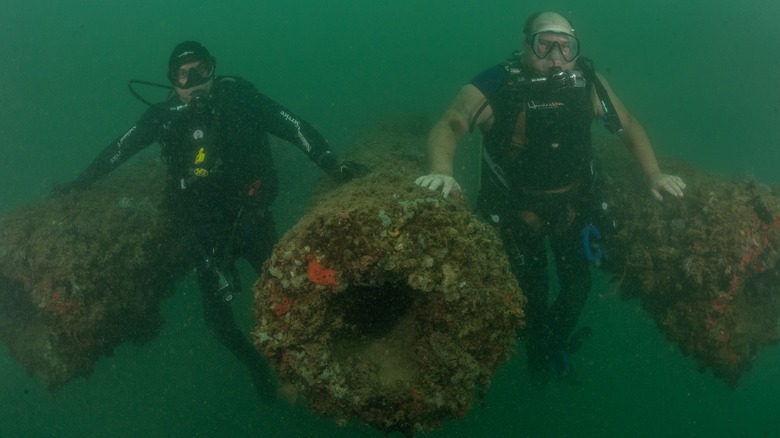What Happened To The Bodies At Pearl Harbor?
We are used to seeing members of our military who gave their lives in service to the nation interred with great respect and honor in places like Arlington National Cemetery and near battle sites abroad, such as the American Battle Monuments Commission's Normandy American Cemetery at Colleville Sur Mer, and the Sicily Rome American Cemetery near Anzio, Italy, also overseen by the Monuments Commission.
It is even more poignant, however, to know that the resting places of many of the 2,403 servicemen who were killed in the attacks on Pearl Harbor on December 7, 1941, according to the U.S. census, are still under the waters of the harbor, with no way to pay respects to each individual for their ultimate sacrifice.
The surprise aerial bombardment of Pearl Harbor, which came with no warning from a nation that had not declared war on the United States – indeed its diplomats were in Washington, D.C. at the time, engaging in peace talks – was so deadly that it is still difficult to grasp its enormity. The remains of more than 1,000 servicemembers still lie in the harbor or are interred forever in the wrecks of the ships on which they served.
1,104 servicemen were killed on the USS Arizona
The Pearl Harbor attacks were carried out by 353 Japanese aircraft launched from six aircraft carriers; the surprise attack presaged the entry of the U.S. into World War II, announced one day later. A total of 1,104 men were killed aboard the Arizona, the greatest loss of life of those who served aboard ships in Pearl Harbor, according to U.S. government figures. Out of 1,511 crewmembers, 1,177 perished; only 334 survived. Fully fueled, the Arizona also had vast quantities of armaments aboard when the attack began. As told by the National WWII Museum, a bomb pierced the Arizona's forward powder magazine, creating a hellish inferno, lifting the ship into the air by the force of the explosion.
After burning for two and a half days along "Battleship Row" in Pearl Harbor, the 33,000-ton behemoth, a super-dreadnought, was not much more than a mass of metal and oily sludge. With most of the dead killed instantly, leaving no remains, only 107 bodies could even be identified. The rest –- 1,070 men — would be classified as either not found, not identifiable, or unreachable due to where they were located within the ship, as The Mirror relates. The loss of the USS Arizona represented the greatest loss of life in American naval history, notes the National Park Service, which operates the visitors' center atop the vessel today.
The USS Arizona has been declared a mass grave
Just months after the attacks, U.S. government officials decided that the Arizona would be kept in place in the harbor and designated as a mass grave site since it would be too difficult to remove the bodies with the respect and dignity the servicemen deserved. According to mortician Caitlin Doughty in an interview with The Mirror, "At the time of the attack, identification or retrieval of the bodies was pretty much impossible."
Just months after the attack, when other ships that had sustained less damage were returning to service — despite the fact that they were scenes of enormous loss of life — government officials decided that the Arizona, along with the Utah, would be kept in their berths in the harbor and declared mass grave sites since it would be too difficult to remove the bodies with the respect they deserved, as noted by The Mirror. The decision was made only after a great deal of deliberation, according to Mauka Tours. It sits in its berth today as a sacred site of pilgrimage, as the periodical Scuba Diving notes, with the white, wing-like building constructed above it welcoming 1.7 million visitors per year.
The USS Oklahoma is now at the bottom of the Pacific
As cruel as fate was for those who died aboard the USS Arizona — and their families – it was in one respect even worse for the 429 sailors killed aboard the USS Oklahoma and their survivors, as the National Park Service states in its history of the Pearl Harbor attack. Hit by eight torpedoes in the first 10 minutes of the attack, it capsized two minutes after the first barrage; the USS Oklahoma then became an upside-down, pitch-black steel prison for those trapped in its hull, as related by the Oklahoma Historical Society. As mortician Caitlin Doughty notes in The Mirror, "For the families of those that died aboard ships like the USS Oklahoma, there is no closure, as no wreck remains of the battleship."
What was left of the men who had died trapped in her overturned hull were retrieved in haste as the ship's parts were salvaged. Unfortunately, this resulted in caskets that many times contained the remains of several men. The Oklahoma later sank in the middle of the Pacific as it was being towed to its final salvage point on the West Coast. As noted by the Oklahoma State Senate, a memorial at Pearl Harbor's Ford Island dedicated to those who died aboard the overturned ship is the only site where relatives can pay their respects to the men lost aboard the Oklahoma.
Another 106 were killed aboard the USS West Virginia
A dreadnought of the Colorado class, the West Virginia, weighing 32,000 tons, was hit by two bombs and seven torpedoes on December 7. As the Naval History and Heritage Command relates in its history of the day, although more than one hundred men were lost in the attacks, the skillful maneuverings of the mortally-wounded Captain Mervyn Bennion, who issued orders even as he lay dying, ensured that the ship remained upright as it sank, ensuring that no sailor would have to endure being trapped upside down.
Some were nevertheless trapped in compartments inside the burning ship; according to the Dictionary of American Fighting Naval Ships, the bodies of 70 men were found as repairmen worked on refitting the ship two years later. In a chilling and macabre discovery at that time, a calendar that was found amongst the human remains showed days that had been marked off every day after the attack until December 23 — more than two weeks after the attack. In his official report on the attack to the U.S. Pacific Fleet Headquarters, R.H. Hillenkoetter, the commander of the USS West Virginia, recorded many stories of heroism aboard the ship despite the loss of so many men; many of the survivors were forced to dive into the oily water — which in places had caught on fire — while one ensign who was ashore at the time of the attacks swam to the ship to help save as many people as possible.
98 servicemen were killed aboard USS California
Sustaining hits from both torpedoes and bombs in the attack at Pearl Harbor, the USS California nevertheless took two days to sink to the bottom of the harbor. But her men were valiant in their attempts to fight the attacking Japanese, as told by the Naval History and Heritage Command. No less than four sailors and one officer from the California were awarded the Medal of Honor, the most prestigious military award in the United States.
The National World War II Museum states that Ensign Herbert Jones, the most senior officer aboard when the attack occurred, saved one sailor from a smoke-filled compartment before being mortally wounded in another blast; he refused to be evacuated or attended to while so many other men had been killed aboard the ship. Although her salvage and repair took more than two years to complete, this ship, which had lost almost 100 of her sailors, returned to combat, taking part in the battles for Saipan, Tinian, Guam, and the Battle of Surigao Strait, the Naval History and Heritage Command notes.
The USS Utah was declared Pearl Harbor's second mass grave
The Utah, which had been decommissioned by the time of the Pearl Harbor attack, was targeted in error by a Japanese pilot; six torpedoes were wasted on the ship – which would not have taken part in any battles in the Pacific anyway — and 58 men were killed, either after being trapped in the hull or when they tried to swim ashore through the burning oil atop the water, according to the Honolulu Star-Bulletin. The Utah is one of three warships considered total losses from the attack; along with the Arizona, she still lies in her berth in Pearl Harbor, with the bodies of some of her men aboard.
For decades, there was no recognition whatsoever of the dead whose remains are on the ship. As reported by the Star-Bulletin, When the Utah's Chief Yeoman Albert Wagner, who survived the attack, visited her in subsequent years, he stated, "There was nothing but mud then, and no indication that there are men still aboard." Incredibly, that was the case until 1972, when a concrete pier and memorial slab were dedicated at the site, the organization for survivors of the USS Utah 1941 notes. Now, Navy sailors raise and lower a flag there each day in respect for the fallen whose remains are entombed there.
The bombing of the USS Shaw is an iconic Pearl Harbor image
The USS Shaw sustained severe damage from the Japanese attack of December 7, 1941, even coming to epitomize the destruction that day in the iconic image showing a direct hit on the ship. As reported by World War II Headquarters, the Shaw, the target of multiple bombings from the brutal second wave of attack, took hits to her machine gun platform, forecastle, main decks, and the crew's mess room; coming at 7:55 on a Sunday morning, the attacks undoubtedly killed many as they ate breakfast onboard.
Her forward ammunition magazines were ignited approximately 30 minutes after the attacks, according to the Naval History and Heritage Command, resulting in the spectacular fireball that gave the public the most iconic image of the Pearl Harbor attacks. The Shaw was soon engulfed in flames, and the captain subsequently ordered his men to abandon ship. Many leaped overboard and were able to save themselves, but 24 men succumbed as a result of the bombings and the all-consuming fires that resulted from the explosion of the magazine. Despite losing 24 men in the hellish conflagration — as well as her entire bow section — the USS Shaw was back at sea in a matter of months, earning no fewer than 11 battle stars, according to the naval history website Hull Number.
The USS Pennsylvania was one of very few ships able to return fire
This gigantic warship USS Pennsylvania, a sister ship to the Arizona, was much more fortunate than her dreadnought sibling in the attack on December 7. Sustaining few direct hits, her crew has the distinction of being some of the only servicemen who were able to open fire and counterattack the Japanese planes that day.
The Pennsylvania, a super-dreadnought that was the sister ship of the Arizona, was repaired so quickly that she left Pearl Harbor less than two weeks after the attack, despite being strafed by Japanese bombers, the USS Pennsylvania's website explains. A bomb destroyed her entire 5-inch gun mount, killing all the crew members manning it. Altogether the Pennsylvania lost 15 officers and men, with 14 listed as missing in action, according to the World War II Database. The Pennsylvania was able to steam to San Francisco by December 20, however, where she underwent repairs before taking part in further action in the war.
535 men were killed on the Nevada and other Pearl Harbor ships
The USS Nevada, Helena, Curtiss, Chew, Dobbin, Enterprise, Maryland, Pruitt, Sicard, Tracy, Vestal, Downes, and Tennessee were among the other ships that sustained casualties amongst their crews in the surprise attack at Pearl Harbor, with 535 servicemen killed in all. The Nevada, weighing 27,500 tons, was the only ship at Pearl able to get underway after the attacks began; because of this, she was subject to furious attacks. She beached after losing 50 officers and men, according to the Naval History and Heritage Command, but later was able to be salvaged. She went on to take part in the invasion of Normandy, among other notable battles. Sadly, she was used as part of the atomic bomb tests at Bikini Atoll and was so radioactive she had to be sunk, the Naval History and Heritage Command notes.
The crew of the USS Helena had the distinction of shooting down no less than six Japanese dive bombers after the attack began, amidst her fierce counterattack that saw the Helena unleash an incredible 375 shells, as related by Kermit Bonner in his book "Final Voyages," despite the loss of 33 men.
A single grave contains the remains of 90 Pearl Harbor victims
Many bodies recovered from the warships and the harbor after the horror of that day were interred in Pearl Harbor's National Memorial Cemetery located near the harbor, as noted by the U.S. Department of Veteran's Affairs; some of the 70 men interred there were originally unidentified but were later proven by DNA analysis to have perished aboard the Arizona, states The Mirror. Many remains recovered from the USS Oklahoma were also buried there. The government ruled after the attack that all the remains found on that ship be collected into "sets" of as many bones for each skeleton as possible, resulting in many remains being mixed with others.
DNA tests performed in 2003 on the remains in one casket which, when opened, was seen to contain parts of four men, proved there were actually remains of 90 different men there. One of them was Eldon Wyman, who was reburied with full military honors in 2008, and whose story was told by The Oregonian. His body was only recovered two years after the attack during a salvage operation on the Oklahoma, the Navy Log states, when the remains of 381 men were removed and buried in "sets" at the National Memorial Cemetery of the Pacific. After a concerted campaign to identify all the unknowns at the cemetery and a report to the Joint POW/MIA Accounting Command in 2003, Wyman's sister, Kathleen Wyman, provided the DNA to make the identification possible, The Oregonian states.
New DNA research has led to improved identification
As the National Park Service notes, if it were not for the indomitable researcher Ray Emory, a Pearl Harbor survivor himself, few of Pearl Harbor's unknown fatalities would even be identified today. First interred in small cemeteries, all the remains of the 429 dead from the USS Oklahoma were later taken to the Central Identification Laboratory at Hawaii's Schofield Barracks in 1947; however, only 35 men were able to be identified at that time, using traditional methods such as dental records and, of course, dog tags.
The creation of the Defense POW/MIA Accounting Agency in 2015 enabled many of the dead to be identified as researchers from the Armed Forces DNA Identification Laboratory worked with families and descendants living all over the U.S. The advanced DNA analysis techniques available today have now enabled researchers to identify a staggering 90% of the men who perished aboard the Oklahoma, as part of "The USS Oklahoma Project," Politico reports. Announcing that the laboratory had identified 361 of the remaining 391 men, John Byrd, the director of Hawaii's Central Identification Laboratory, told Politico, "It was a milestone accomplishment for the laboratory. We've identified over 90% of these individuals." Now, Byrd adds, the success of the lab's efforts has given hope for the eventual identification of the remaining 45 men whose remains were found in the USS California and the USS West Virginia.
Scuba divers honor the dead in the Pearl Harbor shipwrecks
Because of the great respect that must be shown to the dead whose remains are interred forever in the Arizona and other wrecks at Pearl Harbor, only a few, specially-chosen divers have the privilege of exploring the harbor, as reported in the periodical Scuba Diving. These divers are allowed to pay their respects to the men whose remains will forever be interred aboard the 608-foot-long ship, which is now heavily encrusted with corals and sponges. Some of them are even given the somber duty of placing the ashes of servicemen who choose to be interred in these ships along with their fallen crewmates.
PN Online, the journal of the Paralyzed Veterans of America, states that its members also dive at the sites of the Pearl Harbor wrecks as part of an annual event to commemorate the dead, to monitor the decay rates of the ships, and to note the position of objects in the debris field and to check on the environmental impact of the wrecks since the Arizona is still leaking oil. All the Pearl Harbor shipwrecks — along with the remains of the 180 aircraft that were lost that day — are under the auspices of the National Park Service, which ensures that the watery graves of the brave servicemen who gave their lives that day are treated with the proper respect.
